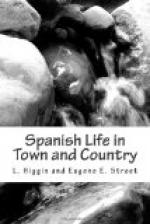Between the dances the pauses were unusually long, but they were never spent by the ladies sitting in rows round the walls, while the men blocked up the doorways and looked bored. There were no “flirting corners,” and sitting out on the stairs a deux would have been a compromiso. The whole company broke up into little knots and circles, the chairs, which had been pushed into corners or an ante-room, were fetched out, and the men, without any sort of shyness, generally seated themselves in front of the ladies, and kept up a perfectly wild hubbub of conversation until the music for the next dance struck up. Dowagers and duenas were few; they sat in the same spot all the evening, and asked each other what rent they paid, how many chimeneas (fireplaces) they had, whether they burned wood or coal, and lamented over the price of both. They reminded one irresistibly of the “two crumbly old women” in Kavanagh “who talked about moths, and cheap furniture, and the best cure for rheumatism.”
The dances were the same as ours, with some small differences: the rigodon is a variation of the quadrille, and the lancers are slightly curtailed. There was a decided fancy for the polka and a species of mazurka, which I remembered having learned from a dancing-master in the dawn of life, under some strange and forgotten name. Spaniards dance divinely—nothing less. They waltz as few other men do, a very poetry of motion, an abandonment of enjoyment, as if their soul were in it, especially if the music be somewhat languid. This is especially the case with the artillery officers, who are great favourites in society, and belong exclusively to the upper ranks.
I have described this tertulia at length because it was a typical one of many. The cotillon was a great favourite, and generally closed the evening. I always had an idea that one cause of its popularity was the extended opportunities it gave for a couple who found each other’s company pleasant to enjoy it without much interference. It rather made up for the loss of the staircase and the window-seats, or balconies, dear to English dancers. The rooms are generally kept in a stifling state of heat, a thick curtain always hanging over the door, and never an open window or any kind of ventilation; this, however, does not inconvenience the Spaniard in the least. It is usual to smoke during the intervals of the dances—cigarettes as a rule; but I have often known a man to lay his cigar on the edge of a table, and give it a whiff between the rounds of a valse to keep it going.




